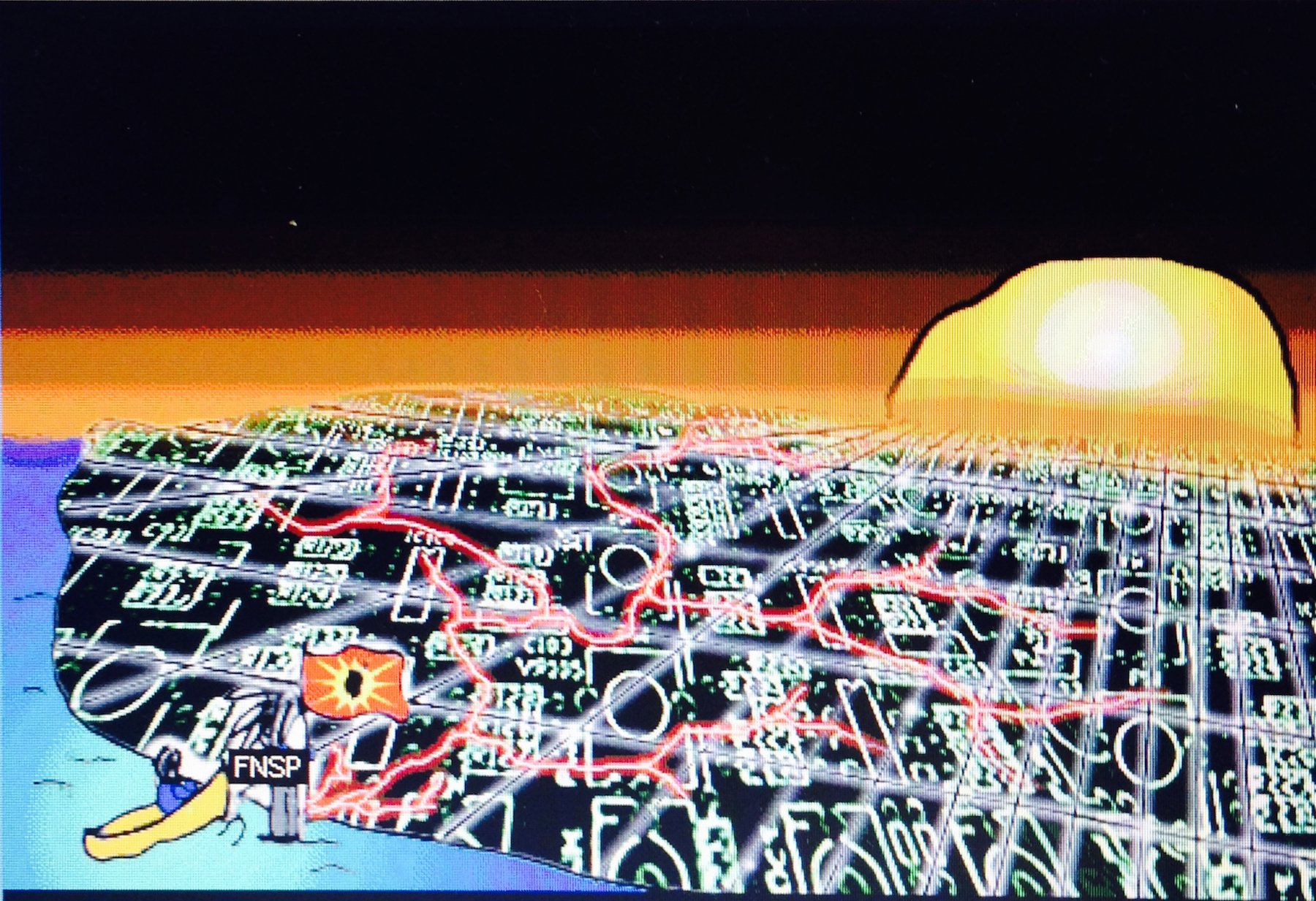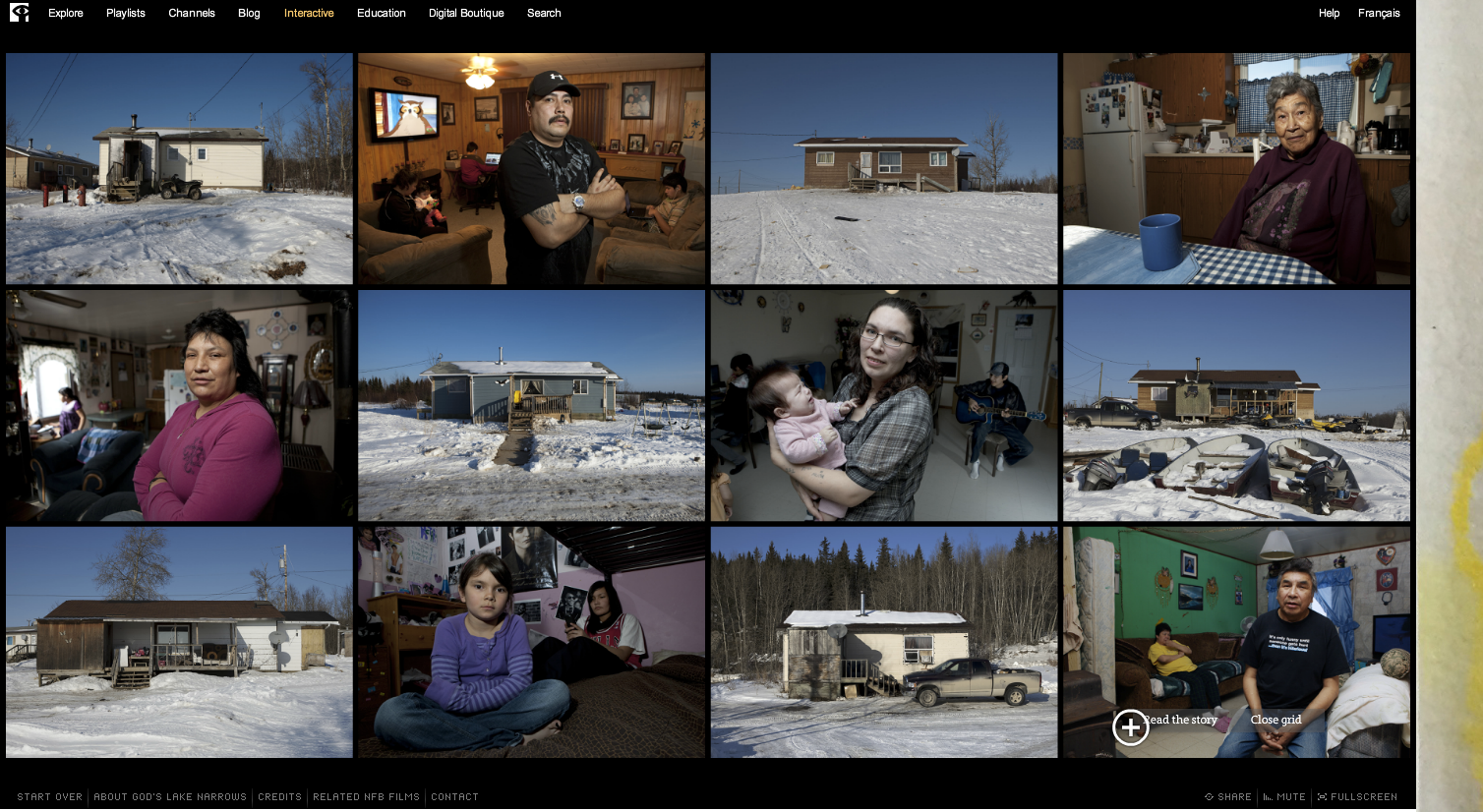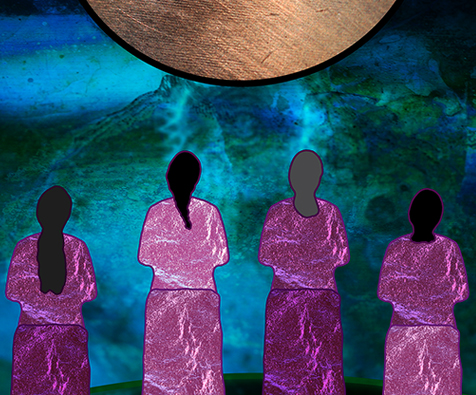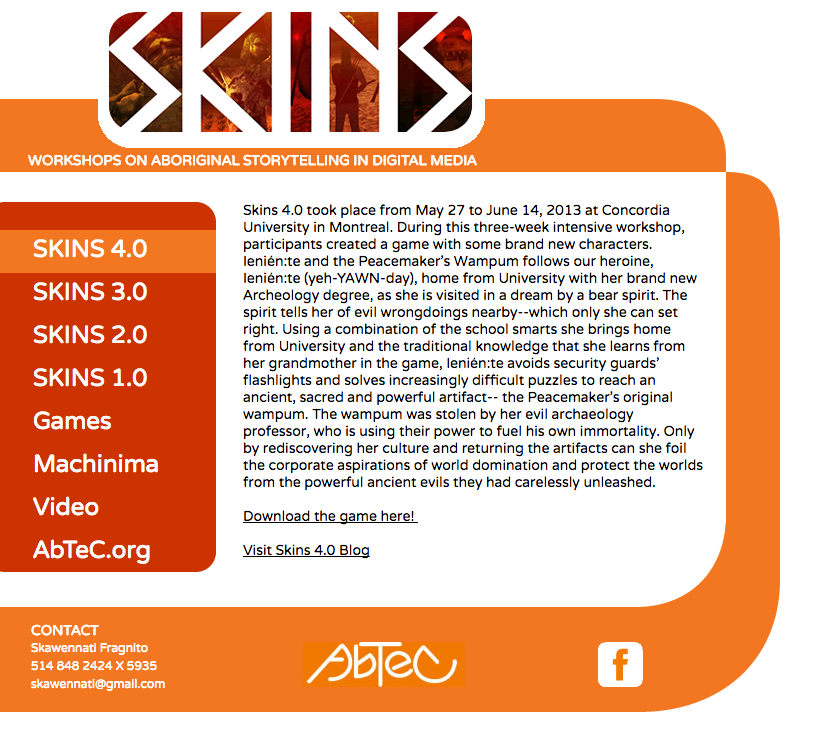Indigenous
David Gaertner
¶ 1 Leave a comment on paragraph 1 0 University of British Columbia (First Nations and Indigenous Studies Program)
Karyn Recollet
¶ 2 Leave a comment on paragraph 2 0 University of Toronto (Women and Gender Studies Institute)
with Elizabeth LaPensée
¶ 3 Leave a comment on paragraph 3 0 Michigan State University (Media & Information and Writing, Rhetoric, and American Cultures)
¶ 4 Leave a comment on paragraph 4 0 Please visit the final version of Digital Pedagogy in the Humanities, where you can read the revised keywords and create your own collections of artifacts.
¶ 5 Leave a comment on paragraph 5 0 The official reviewing period for this project has ended, and commenting is closed.
CURATORIAL STATEMENT
¶ 6 Leave a comment on paragraph 6 0 In the context of digital studies, we understand “Indigenous” in relation to Indigenous places, bodies, and futures. Traditionally framed as a “landless territory,” Western conceptions of cyberspace risk eliding the core principles of critical Indigenous studies, which are founded in place-based pedagogies. Evoking “Indigenous” in digital environments thus raises vital questions about our relationships to cosmologies, space, and lands. It also compels us to ask whether Indigenous lands and life can be repatriated through forms of creative intimacies formulated as cyber-justice.
¶ 7 Leave a comment on paragraph 7 0 The pedagogical resources gathered here connect with “Indigenous” as an opportunity to:
- ¶ 8 Leave a comment on paragraph 8 0
- Conceive of new relationships to land and cyberspace through the digital,
- Envision new ways of conceptualizing land as multiscalar,
- Reconceive “extractivism” in digital spaces,
- Explore and critique the unique intimacies and connections available through cyberspace, and
- Reorient cyberspaces in relation to colonialism and Indigenous histories.
¶ 9 Leave a comment on paragraph 9 0 In the classroom, Indigenous perspectives on digital studies promote critical understandings of and engagement with the colonial foundations of media analysis and the “whiteness” (McPherson) of the field through critical analysis and place-based learning. Too often Indigenous peoples and knowledges are seen as mutually exclusive to modernity and technology. Our pedagogy pushes for nuanced understanding of “traditional innovation” (Glaskin), the crossroads at which Indigenous pasts, presents, and futures meet and expand into new worlds.
¶ 10 Leave a comment on paragraph 10 0 Engagement with Indigenous new media technologies also encourages students to find spaces of safety, love, and breath within an environment (the digital) that has traditionally been alienating and even hostile for Indigenous peoples, particularly Indigenous women and non-gender conforming peoples. We take seriously the possibility of radical decolonial love as proffered by Anishinaabe artist/activist/scholar, Leanne Simpson, as well as Cree scholars, Billy-Ray Belcourt and Kirsten Lindquist. Such love may have a glitching effect on the colonial machinery of technology. The glitch (Belcourt) provides spaces for rematriative sonic, visual, and embodied sovereignties and thus imagines, designs, and activates new futurisms that are anything but frontier spaces.
Our Own Pedagogy
¶ 11 Leave a comment on paragraph 11 0 We have compiled these resources from both Indigenous and non-Indigenous engagements with Indigenous new media and Indigenous futurism. The pieces we have selected offer Indigenous critiques of settler colonial structuring, namely their erasures in a project of Indigenous dispossession. We begin with the idea that cyberspace and the digital are not Western phenomena. For instance, it is our belief that virtual reality is ancient; our elders have always worlded through space-time travel. Cyberspace has always existed for Indigenous people. Mohawk new media scholar, Steven Loft, argues that the fact “that hardware technology has made [cyberspace] accessible through a tactile regime in no way diminishes its power as a spiritual, cosmological, and mythical ‘realm’” (175). Additionally, Angela Haas has convincingly argued that Wampum is an early, Indigenous example of hypertext: “both Western and wampum hypertexts employ digital rhetoric to communicate non-linear information” (84). Understanding cyberspace as a notional environment that Indigenous peoples have conceptualized in parallel to Western technology provides new depth to understanding the limitations and possibilities of that space. Indigenous folks have enacted the traditional in the future by activating the “slipstream” as a platform or portal space to dream up new possibilities (Dillon; Jackson; Belcourt), where “imagining otherwise” (Crawley) is the glitch. The slipstream represents creases in space-time to produce radical constellatory genealogies and connectivities to land spaces. For example, relationships to human and non-human, the not yet and the already present, are activated within and through breath in LaPensée’s Honour Water. As an act of coming up for air, the breath itself is a worlding process, and such futuristically ancient activations have always been multiscalar. Radical relationality does this for digital pedagogy: it activates all that is underneath, above, and around. An Indigenous digital commons is a radical mapping exercise of love and futurity building.
Rationale and Criteria
¶ 12 Leave a comment on paragraph 12 0 We have selected the following resources according to four broad principles, which apply to our teaching and research:
¶ 13 Leave a comment on paragraph 13 0 First, we chose resources that were created by Indigenous artists, authors, programmers, and media makers, simply to highlight the cutting-edge work Indigenous media makers are doing and to push back against the persistent settler colonial notion that Indigeneity and digital technologies are incompatible. In this sense, we resist the word “artifact” in the way it connotes historical interest. The pieces we have chosen are all connected to living moments, places, peoples, and cultures, and they evoke continued conversation and the projection of Indigenous peoples and knowledges’ real and imagined futures.
¶ 14 Leave a comment on paragraph 14 0 Second, we wanted to include a range of projects that explore and expand the range of digital pedagogy, Indigenous new media, and Indigenous futurisms, including the multifarious ways in which these works connect users to places and bodies or ask them to engage in critical thinking about place and body. As such, we have included works that engage users visually, sonically, and haptically, blurring the distinctions between the digital and the analogue.
¶ 15 Leave a comment on paragraph 15 0 Third, we included resources that both throw into relief the colonial implications of cyberspace, but also recast those spaces for Indigenous peoples to reimagine the possibilities of the digital and imagine Indigenous bodies in future worlds.
¶ 16 Leave a comment on paragraph 16 0 Finally, the examples we include all explore, in different ways, what we call kinstillatory relationalities: that is, the ways in which kinship is built, maintained, and folded across time and space to produce radical constellatory genealogies and connectivities to community and land spaces. We see cyberspace and digital pedagogy as possible extensions of kinship models developed on the land and developed by Indigenous scholars such as Daniel Heath Justice. Kinship, Justice writes, “is best thought of as a verb rather than a noun, because kinship, in most Indigenous contexts, is something that’s done more than something that simply is” (150). We see cyberspace as another plane for the work of kinship to be done on new scales of time and place, providing powerful constellations of affinity and relationship.
CURATED ARTIFACTS
ALie Nation

ALie Nation
- ¶ 18 Leave a comment on paragraph 18 0
- Source URL: https://www.youtube.com/watch?v=WhlKs_3Srj0
- Creator: A Tribe Called Red
¶ 19 Leave a comment on paragraph 19 0 ALie Nation is a site of activation from which students can begin to reflect on the complex relationships between Indigeneity, modernity, and digital space. The urban environment A Tribe Called Red (ATCR) captures, moves through, and writes over is registered not simply as a space of oppression for Indigenous peoples (although that critique is present), but of possible futures, in which modernity and the gaze itself are captured from a top-down, Indigenous point of view. We suggest that the poetics of its title, A Lie Nation, is of course an Alien nation: a society of immigrants convinced of their native belonging to stolen land. But the deeper lie may also be the Ally-Nation, a citizenry that loudly asserts its apologies and goodwill while leaving the colonial machinery to run unabated. Instructors inspired by this video might ask students to reflect on the poetics of its title and the Jeremy Bentham-inspired logo featured within it. What does “alienation” mean within the contexts of the digital? How are ATCR mobilizing those same spaces towards Indigenous resistance and resurgence?
Ashes on the Water

Ashes on the Water
- ¶ 21 Leave a comment on paragraph 21 0
- Source URL: http://neworldtheatre.com/portfolio-item/podplays/
- Creator: Quelemia Sparrow
¶ 22 Leave a comment on paragraph 22 0 Ashes on the Water is a podplay, a piece of interactive theatre that audiences download onto a smartphone and then listen to while walking on a particular piece of land. Ashes is set on Squamish territory in what is now known as CRAB PARK in Vancouver, British Columbia. It tells the story of the Women’s Paddle Song, which was written by Squamish people in 1886 as they rowed across the Burrard Inlet to rescue settlers fleeing Vancouver’s Great Fire. Instructors interested in this piece might ask students to consider the ways in which Sparrow’s work closes the gap between the digital and the material, or to consider the ways in which oral storytelling works as an augmentative technology. This piece is best experienced on the land itself, but for those not in Vancouver it stands as a story on its own. It can also be experienced from a distance using Google maps or other mapping software.
Podcast Pedagogy

Podcast Pedagogy
- ¶ 24 Leave a comment on paragraph 24 0
- Source URL: https://rebadeguevara.wordpress.com/2015/12/31/podcast-pedagogy-stories-from-the-land/
- Creator: Reba De Guevera
¶ 25 Leave a comment on paragraph 25 0 “Podcast Pedagogy” is an example of a final blog post assignment written by an undergraduate student for FNIS 401F (Indigenous New Media and Digital Storytelling) taught at the University of British Columbia. In the post, the author explores the relationships between land, storytelling, and digital technologies via a close reading of Anishinaabe media-maker Ryan McMahon’s podcast, Stories from the Land. The blog post is an excellent example of close reading practices as applied to podcasting and Indigenous storytelling and can be integrated into syllabi as a prompt for students writing on similar topics. Instructors might ask their students to reflect on the ways in which De Guevera incorporates land into a conversation about technology.
Where the Red Receives Me

Where the Red Receives Me
- ¶ 27 Leave a comment on paragraph 27 0
- Source URL: http://www.philome.la/chloerlendson/where-the-red-receives-me/play
- Creator: Chloe Erlendson
¶ 28 Leave a comment on paragraph 28 0 “Where the Red Receives Me” is a digital storytelling assignment written by an undergraduate student for Indigenous New Media, taught at the University of British Columbia. For this assignment, the student used Twine (interactive storytelling software, workshopped in class) to remediate a poem written by the student’s mother about her Métis identity. The story works well in classrooms as an example of the ways in which family and community stories can be shared and revitalized through digital media. “Where the Red Receives Me” is also a good example of the type of interactive storytelling that can be done using Twine in the classroom and the ways in which Indigenous storytelling and technology intersect.
FNIS 454: Indigenous New Media and Digital Storytelling

FNIS 454
- ¶ 30 Leave a comment on paragraph 30 0
- Source URL: https://novelalliances.com/2016/10/30/fnis-454-indigenous-new-media-and-digital-storytelling/
- Creator: David Gaertner
¶ 31 Leave a comment on paragraph 31 0 Rationale: FNIS 454 represents an entire upper-level course built around the intersections and divergences of critical Indigenous studies and new media/the digital humanities. The syllabus provides a number of primary and secondary sources as well as assignments and a rationale. FNIS 454 (or portions thereof) can be used and adapted for courses on new media and digital humanities contending with Indigenous studies, futurisms, and critical race studies. The syllabus also includes assignments, such as blog post prompts and a new media design project adapted for the Indian Residential School History and Dialogue Centre at UBC.
Ay I Oh Stomp

Ay I Oh Stomp
- ¶ 33 Leave a comment on paragraph 33 0
- Source URL: https://www.youtube.com/watch?v=FS43pk8Yjos
- Creator: Skookum Sound System
¶ 34 Leave a comment on paragraph 34 0 Students are asked to produce sonic and/or visual maps, engaging the narratives of future relationships towards lands and territories, thus creating an artistic production which considers how we can activate (re)mapping to explore complex land histories. This assignment allows students to practice, in their own ways, creative intimacies with the spatial scales of land, bodies, and territories (water, land-terrestrial, or celestial). The video, Ay I Oh Stomp, by Skookum Sound Systems can be read as a sonic map illuminating the time/space collapse mobilized through the remix. We ask students to create visual/sonic maps to explore the futuristic narratives of lands and territories through layering lands/territories/waters, or celestial maps remixed with recorded futurity narratives (this could take the form of spoken word poetry or other narrative devices). Students can read the text, “Gesturing Indigenous Futurity through the Remix” (Recollet), considering in particular how mapping (visual, choreographic, spatial, and sonic) carries potential for reworlding through digitally remixed platforms.
CyberPowWow

CyberPowWow
- ¶ 36 Leave a comment on paragraph 36 0
- Source URL: http://www.cyberpowwow.net/
- Creator: Skawennati
¶ 37 Leave a comment on paragraph 37 0 CyberPowWow was the first interactive, online, Indigenous art gallery running from 1997–2004. Using software from the Palace (early graphical chatroom platform owned and operated by Time Warner), Mohawk artist Skawennati curated artworks created by Indigenous artists in a linked, interactive space. Artists then convened in those spaces via avatars (also designed by Indigenous artists) to share and discuss the work. A large part of how CyberPowWow was imagined was through the performativity of the space: participants and their conversations were core to how the art and poetics of the piece functioned. In this sense, the gallery was an early instantiation of Web 2.0 thinking. CyberPowWow went dark in 2004, so it is no longer “live” in the same sense, but students and teachers can still explore some of the visual and written pieces created for it in the curated link. Instructors should encourage students to engage the spaces in groups and encourage conversation in and around the artwork. Students should also be encouraged to visit the “library.” Texts in this space can be used to critically analyze the artwork.
God’s Lake Narrows

God’s Lake Narrows
- ¶ 39 Leave a comment on paragraph 39 0
- Source URL: http://godslake.nfb.ca/#/godslake
- Creator: Kevin Lee Burton
¶ 40 Leave a comment on paragraph 40 0 God’s Lake Narrows is an interactive website written and designed by Swampy Cree artist, Kevin Lee Burton. The website is based on an installation piece that Burton originally conceived for the Urban Shaman Gallery in Winnipeg, Manitoba. Both the installation and the website were conceived as spaces to introduce non-Indigenous people, who would likely never visit in real life (IRL), to life on Burton’s reservation and thus disrupt many of the stereotypes about reservation life. What makes Burton’s work so provocative is how he uses technology to provide access to home, but also how he brings Internet and Indigenous protocols together to evoke hospitality and guesthood in that space. Teachers can use this piece to initiate conversation about the relationship between Indigenous land and cyberspace and Internet protocol and community protocol. Consider, for instance, how Burton uses geotagging to identify users and how he inverts the gaze (see in particular the “about” page).
Honour Water

Honour Water
- ¶ 42 Leave a comment on paragraph 42 0
- Source URL: http://www.honourwater.com/
- Creator: Elizabeth LaPensée
¶ 43 Leave a comment on paragraph 43 0 Elizabeth LaPansée’s Honour Song activates Anishinaabemowin songs gifted by Sharon Day, the Oshkii Giizhik Singers, and Elders. Repatriating Indigenous land and life as in-motion or in-migration through the kinesthetic waves of water, Honour Song activates Indigenous intelligence through voicing forms of “sonic intimacies” (Campbell) between bodies and waters in digital space-time. Since water holds space underneath the gravel and concrete of the cities, Honour Song can be introduced to the students as an exercise of spatially/sonically mapping the oftentimes hidden (paved over, buried) underground waterways in citified Indigenous territories. Students are encouraged to research and travel to the portal sites of underground waterways in respective Indigenous territories and build sonic intimacies through the act of singing water songs along with the app. Be mindful of how the body is being realigned/reoriented in relationship to the sound kinesthetic (how sounds shape space) produced through singing in Anishinaabemowin. Consider the ways in which sound shapes movements, flows, and migrations throughout the cities as gathering spaces. How might these flows (sonically, in relationship within the bodies of water) be acknowledging radical alterities? Who are the Indigenous stewards/caretakers and those visioning futurities in the city within which you are living, and how might these original languages/songs impact the futurities of water?
Skins: Workshops on Aboriginal Storytelling in Digital Media

Skins
- ¶ 45 Leave a comment on paragraph 45 0
- Source URL: http://skins.abtec.org/game_.html
- Creators: Jason Lewis & Skawennati
¶ 46 Leave a comment on paragraph 46 0 Skins is a unique digital media workshop for Indigenous youth, designed and facilitated by an “Aboriginally determined team of game designers, artists and educators” known as Aboriginal Territories in Cyberspace (AbTeC). Via the URL provided here, students can download videogames designed in these workshops and read blog entries from the game makers. A documentary on the workshop and a curriculum are also available for instructors. The data provided through the URL are great for students to consider the intersections between tradition and innovation (Glaskin) and experience the ways in which Indigenous youth are mobilizing technology towards Indigenous storytelling in cyberspace (Todd).
RELATED MATERIALS
¶ 47 Leave a comment on paragraph 47 0 Aboriginal Territories in Cyberspace. http://www.abtec.org/
¶ 48 Leave a comment on paragraph 48 0 Loft, Steven and Kerry Swanson. Coded Territories: Tracing Indigenous Pathways in New Media Art. http://press.ucalgary.ca/books/9781552387061
¶ 49 Leave a comment on paragraph 49 0 MacMahon, Ryan. Stories From the Land (podcast). http://www.indianandcowboy.com/stories-from-the-land-podcast/
¶ 50 Leave a comment on paragraph 50 0 Recollet, Karyn. “Gesturing Indigenous Futurities through the Remix.” Dance Research Journal 48.1. https://muse.jhu.edu/article/617353
¶ 51 Leave a comment on paragraph 51 0 Revolutions per Minute (RPM), “Indigenous Futurisms Mixtape,” November 22, 2014, http://rpm.fm/music/download-indigenous-futurisms-mixtape/
WORKS CITED
¶ 52 Leave a comment on paragraph 52 0 @spacendn and @culturite. Revolutions per Minute (RPM), “Indigenous Futurisms Mixtape,” November 22, 2014. http://rpm.fm/music/download-indigenous-futurisms-mixtape/
¶ 53 Leave a comment on paragraph 53 0 A Tribe Called Red. ALie Nation Ft. John Trudell, Tanya Tagaq, Lido Pimienta & Northern Voice. Youtube, September 2, 2016. Web.
¶ 54 Leave a comment on paragraph 54 0 Belcourt, Billy-Ray. Nakinisowin. https://nakinisowin.wordpress.com
¶ 55 Leave a comment on paragraph 55 0 Burton, Kevin. God’s Lake Narrows. National Film Board of Canada, 2011. http://godslake.nfb.ca/#/godslake
¶ 56 Leave a comment on paragraph 56 0 Byrd, Jodi. “‘Do they not have rational souls?’: consolidation and sovereignty in digital new worlds.” Settler Colonial Studies 6.4 (2016). 423–437.
¶ 57 Leave a comment on paragraph 57 0 Campbell, Mark. “Sonic intimacies: On Djing Better Futures.” Decolonization: Indigeneity, Education, and Society. March, 25, 2015.
¶ 58 Leave a comment on paragraph 58 0 Crawley, Ashon. “Otherwise Movements.” The New Inquiry, 2015. http://thenewinquiry.com/essays/otherwise-movements/
¶ 59 Leave a comment on paragraph 59 0 Deerchild, Rosanna. “Indigenous Game Designer CHallenges Stereotypes.” CBC Radio. March 6, 2016. Web. http://www.cbc.ca/radio/unreserved/unreserved-honours-the-strength-of-indigenous-women-1.3472826/indigenous-game-designer-challenges-stereotypes-1.3476519
¶ 60 Leave a comment on paragraph 60 0 De Guevera, Reba. “Podcast Pedagogy: Stories From the Land” Web. December 31, 2015. https://rebadeguevara.wordpress.com/2015/12/31/podcast-pedagogy-stories-from-the-land/
¶ 61 Leave a comment on paragraph 61 0 Dillon, Grace. Walking the Clouds: An Anthology of Indigenous Science Fiction. Tuscan: University of Arizona Press, 2012.
¶ 62 Leave a comment on paragraph 62 0 Erlendson, Chloe. Where the Red Receives Me. Web. 2014. http://www.philome.la/chloerlendson/where-the-red-receives-me/play
¶ 63 Leave a comment on paragraph 63 0 Gaertner, David. FNIS 454: Indigenous New Media and Digital Storytelling. Web. September 2016. https://novelalliances.com/2016/10/30/fnis-454-indigenous-new-media-and-digital-storytelling/
¶ 64 Leave a comment on paragraph 64 0 Glaskin, Katie. “Innovation and Ancestral Revelation: The Case of Dreams.” Journal of the Royal Anthropological Institute 11.2 (2009): 297–314.
¶ 65 Leave a comment on paragraph 65 0 Haas, M. Angela. “Wampum as Hypertext: An American Indian Intellectual Tradition of Multimedia Theory and Practice.” Studies in American Indian Literatures 19.4 (2007): 77–100
¶ 66 Leave a comment on paragraph 66 0 Jackson, Lisa. Vistas: The Visit. National Film Board of Canada (2009).
¶ 67 Leave a comment on paragraph 67 0 Justice, Daniel Heath. “‘Go Away, Water!’ Kinship Criticism and the Decolonization Imperative.” Reasoning Together: The Native Critics Collective. Eds., Craig S. Womack, Daniel Heath Justice, Christopher B. Teuton. Norman: University of Oklahoma Press, 2008. 147–68.
¶ 68 Leave a comment on paragraph 68 0 Johnson, Imani Kai. “Music Meant to Make You Move: Considering the Aural Kinesthetic.” Blog post. Sounding Out. http://soundstudiesblog.com/2012/06/18/music-meant-to-make-you-move-considering-the-aural-kinesthetic/
¶ 69 Leave a comment on paragraph 69 0 LaPensée, Elizabeth. Honor Water. 2016. Ipad.
¶ 70 Leave a comment on paragraph 70 0 ———. We Sing for Healing. Web. 2015.
¶ 71 Leave a comment on paragraph 71 0 Loft, Steven. “Mediacosmology.” Coded Territories: Tracing Indigenous Pathways in New Media Art. Eds. Steven Loft and Kerry Swanson. Calgary: University of Calgary Press, 2014. 169–86.
¶ 72 Leave a comment on paragraph 72 0 Loft, Steven and Kerry Swanson, eds. Coded Territories: Tracing Indigenous Pathways in New Media Art. Calgary: University of Calgary Press, 2014.
¶ 73 Leave a comment on paragraph 73 0 MacMahon, Ryan. Stories from the Land. Web. 2014-Present. http://www.indianandcowboy.com/stories-from-the-land-podcast/
¶ 74 Leave a comment on paragraph 74 0 McPherson, Tara. “Why are the Digital Humanities so White: Thinking the Histories of Race and Computation.” Debates in the Digital Humanities. Ed. Matthew K. Gold. Minneapolis: University of Minnesota Press, 2012.
¶ 75 Leave a comment on paragraph 75 0 Recollet, Karyn. “Gesturing Indigenous Futurities Through the Remix.” Dance Research Journal 48.1 (2016): 91–105.
¶ 76 Leave a comment on paragraph 76 0 Simpson, Leanne. Islands of Decolonial Love. Winnipeg: ARP, 2013.
¶ 77 Leave a comment on paragraph 77 0 Skawennati. CyberPowWow. Web (decommissioned). 1997–2004. Highlights available at http://www.cyberpowwow.net/
¶ 78 Leave a comment on paragraph 78 0 Skookum Sound System. 2012. “Ay I Oh Stomp & Operator” (ft. Deano & Amphibian14). https://www.youtube.com/watch?v=FS43pk8Yjos
¶ 79 Leave a comment on paragraph 79 0 Sparrow, Quelemia. Ashes on the Water. Neworld Theatre. Web. 2011. http://neworldtheatre.com/portfolio-item/podplays/
¶ 80 Leave a comment on paragraph 80 0 Tuck, Eve and Wayne Yang. “Decolonization is not a Metaphor.” Decolonization: Indigeneity, Education & Society 1.1 (2012). Web. http://decolonization.org/index.php/des/article/view/18630
Comments
Comments are closed
0 Comments on the whole Page
0 Comments on paragraph 1
0 Comments on paragraph 2
0 Comments on paragraph 3
0 Comments on paragraph 4
0 Comments on paragraph 5
0 Comments on paragraph 6
0 Comments on paragraph 7
0 Comments on paragraph 8
0 Comments on paragraph 9
0 Comments on paragraph 10
0 Comments on paragraph 11
0 Comments on paragraph 12
0 Comments on paragraph 13
0 Comments on paragraph 14
0 Comments on paragraph 15
0 Comments on paragraph 16
0 Comments on paragraph 17
0 Comments on paragraph 18
0 Comments on paragraph 19
0 Comments on paragraph 20
0 Comments on paragraph 21
0 Comments on paragraph 22
0 Comments on paragraph 23
0 Comments on paragraph 24
0 Comments on paragraph 25
0 Comments on paragraph 26
0 Comments on paragraph 27
0 Comments on paragraph 28
0 Comments on paragraph 29
0 Comments on paragraph 30
0 Comments on paragraph 31
0 Comments on paragraph 32
0 Comments on paragraph 33
0 Comments on paragraph 34
0 Comments on paragraph 35
0 Comments on paragraph 36
0 Comments on paragraph 37
0 Comments on paragraph 38
0 Comments on paragraph 39
0 Comments on paragraph 40
0 Comments on paragraph 41
0 Comments on paragraph 42
0 Comments on paragraph 43
0 Comments on paragraph 44
0 Comments on paragraph 45
0 Comments on paragraph 46
0 Comments on paragraph 47
0 Comments on paragraph 48
0 Comments on paragraph 49
0 Comments on paragraph 50
0 Comments on paragraph 51
0 Comments on paragraph 52
0 Comments on paragraph 53
0 Comments on paragraph 54
0 Comments on paragraph 55
0 Comments on paragraph 56
0 Comments on paragraph 57
0 Comments on paragraph 58
0 Comments on paragraph 59
0 Comments on paragraph 60
0 Comments on paragraph 61
0 Comments on paragraph 62
0 Comments on paragraph 63
0 Comments on paragraph 64
0 Comments on paragraph 65
0 Comments on paragraph 66
0 Comments on paragraph 67
0 Comments on paragraph 68
0 Comments on paragraph 69
0 Comments on paragraph 70
0 Comments on paragraph 71
0 Comments on paragraph 72
0 Comments on paragraph 73
0 Comments on paragraph 74
0 Comments on paragraph 75
0 Comments on paragraph 76
0 Comments on paragraph 77
0 Comments on paragraph 78
0 Comments on paragraph 79
0 Comments on paragraph 80